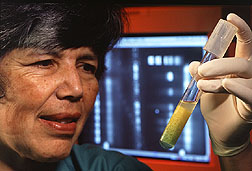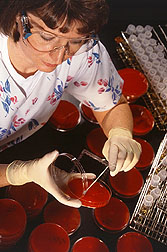Battling Food-Poisoning Bacteria
In 1931, USDA's Bureau of Home Economics published the fourth edition of Aunt Sammy's Radio Recipes, a compilation of the most popular recipes and menus from "Housekeepers' Chats," a 1926 radio program for women.
Today, USDA is still concerned with the preparation of food. But the spotlight now is on food safety rather than cookbooks—on doing everything possible to make sure our food is safe and wholesome.
Every year, 6.5 to 33 million people in the United States get foodborne illnesses. The estimated medical costs and productivity losses range from $6 to $34 billion a year. And the food industry loses money—and product reputations—through embargoes, recalls, and voluntary destruction of products.
For these reasons, the National Food Safety Initiative was begun in 1997. It's a comprehensive national program to improve the safety of food all the way from where food starts—on the farm—to where it winds up—on your table. USDA carries out the initiative along with the Food and Drug Administration, Centers for Disease Control and Prevention, and U.S. Environmental Protection Agency.
Across the country, Agricultural Research Service laboratories at 10 locations are leading the scientific battle against food pathogens in fresh and processed meats, milk, grains, fruits, vegetables, and other foods. The work of just one of these labs is profiled here—the National Animal Disease Center (NADC) in Ames, Iowa.
Researchers at Ames are battling four major bacterial pathogens in food: Campylobacter jejuni, Salmonella, Escherichia coli O157:H7, and Listeria monocytogenes. One major battle is already won: finding faster ways to identify the enemy.
"Each strain of bacteria has a specific genetic fingerprint," says ARS microbiologist Irene V. Wesley. When an outbreak of foodborne illness occurs, Wesley obtains samples of both the food and bacterial isolates taken from individuals who became ill. Her basic studies show that DNA fingerprints of the patients' harmful bacteria match those in foods that made them ill.
In the last 3 years, Wesley and her NADC colleagues have developed several quick and accurate tests to identify foodborne pathogens. The tests use a gene-multiplying technique called polymerase chain reaction (PCR) to recognize pathogens in animal, human, and food samples in less than 8 hours. Culturing techniques, by comparison, can take up to 2 weeks.
|
|
Now the PCR tests are being put to the ultimate test. Wesley and researchers at Iowa and North Carolina State Universities are participating in a project funded by USDA's Food Safety and Inspection Service. They are tracking the spread of Campylobacter, Salmonella, and Yersinia enterocolitica in pigs—from the nursery stage to slaughter. Usually kept in a separate facility, nursery pigs have been weaned but are not yet developed into what is called the grower stage.
The study, which includes eight farms and two slaughterhouses, compares two different ways of raising hogs in Iowa and North Carolina. The results of this study will be used to determine which farm management practices reduce foodborne pathogens.
With a PCR test, Wesley has shown that 90 percent of nursery stage pigs harbor Campylobacter. At slaughter, the organism was found on 17 percent of hog carcasses.
C. coli is a less severe pathogen than its ugly relative—C. jejuni. The latter organism is the leading cause of foodborne bacterial infection in people. Four million C. jejuni infections occur in humans each year in the United States, according to the Centers for Disease Control and Prevention.
Like twins that can trade places without anyone knowing the difference, these two microorganisms are difficult to tell apart. But the PCR test is one of the best ways to do it.
"Because they're so genetically similar, these two bacteria can exchange DNA on the farm. Where C. coli exists, there is also the probability that C. jejuni exists," says Wesley.
In another study, Wesley used the PCR tests to identify C. coli in about 70 percent of 1,300 market-weight hogs. Less than 1 percent of the test hogs harbored C. jejuni. Neither strain of Campylobacter was detected in 29 percent of the hogs sampled.
Keeping an Eye on Cleanliness
Public concern over E. coli O157:H7 has skyrocketed since 1993, when the microbe—in undercooked hamburger patties—killed four children in the Pacific Northwest. In that single outbreak, 477 people were infected from the undercooked, contaminated hamburger.
Foodborne disease-causing bacteria such as E. coli O157:H7 are found in feces and spread to food through fecal contamination. One of the prime ways to reduce bacterial contamination is to reduce fecal contamination in livestock and poultry slaughter facilities. Current federal regulations mandate zero tolerance for visible fecal contamination and for E. coli O157:H7.
At the slaughterhouse, visual inspections and carcass cleaning have been two of the standard tools for reducing the likelihood of E. coli and other bacterial contaminants in meat.
But "the human eye is not very sensitive and often can't tell the difference between feces and blood clots that can be on a carcass," says ARS microbiologist Mark A. Rasmussen at Ames.
Now Rasmussen, ARS microbiologist Thomas A. Casey, and Iowa State University photochemist Jacob W. Petrich have invented a new prototype instrument based on fluorescent spectroscopy.
"We think this instrument has the potential to greatly improve the ability of inspectors to identify small amounts of fecal contamination not detected visually on carcasses," says Casey.
The technology uses specific wavelengths or colors of light to illuminate the carcass. Collected light returned from the carcass is electronically analyzed to determine if the carcass is contaminated. The results are displayed as a numerical value relative to the amount of feces. A contaminated carcass would then be trimmed or sanitized to remove the fecal contamination.
Instruments can be designed to meet the needs of any slaughter facility. They could range in size from a portable, hand-held device similar to metal detector wands used at airports to a larger device capable of detecting fecal contamination on an entire carcass.
The researchers have applied for a patent on the instrument and are constructing and testing other prototype designs. About 60 companies and industry organizations have contacted the researchers. ARS plans to choose an industry partner for a cooperative research and development agreement to develop the prototype into a commercial instrument.— By Linda Cooke McGraw, Agricultural Research Service Information Staff.
This research is part of an ARS National Program on Food Safety described on http://www.nps.ars.usda.gov/programs/108s2.htm.
Irene V. Wesley, Mark A. Rasmussen,and Thomas A. Casey are scientists at the USDA-ARS National Animal Disease Center, P.O. Box 70, Ames, IA 50010; phone (515) 663-7200, fax (515) 663-7458.
"Battling Food-Poisoning Bacteria" was published in the February 1999 issue of Agricultural Research magazine.









